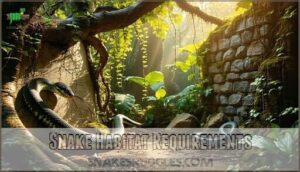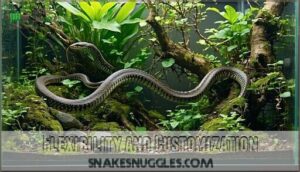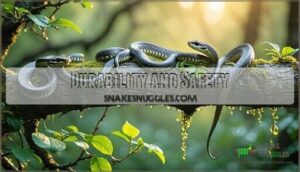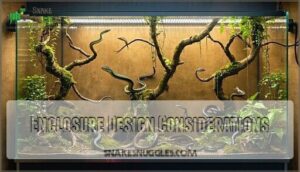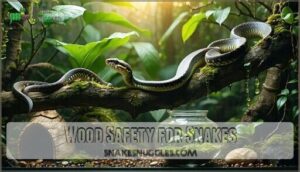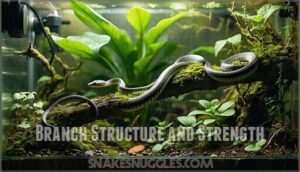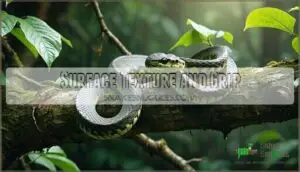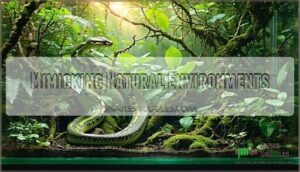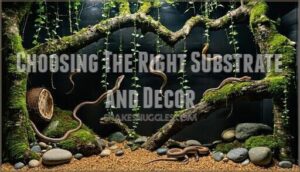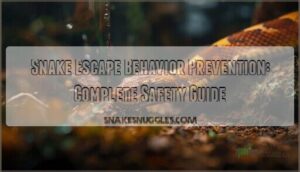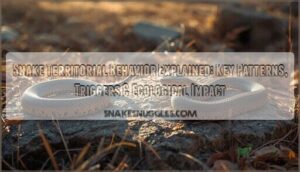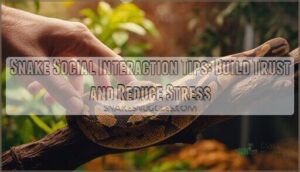This site is supported by our readers. We may earn a commission, at no cost to you, if you purchase through links.
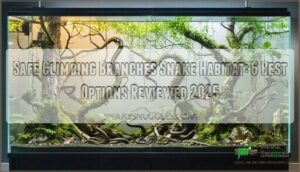
Artificial alternatives work too, but make certain they’re reptile-safe and won’t break under your snake’s weight. The key is choosing branches with proper diameter – thick enough for stability but allowing your snake to grip comfortably.
Most arboreal species thrive when branches span multiple temperature zones in their enclosure. Surface texture matters more than you might think – rough bark gives better grip than smooth surfaces.
Table Of Contents
- Key Takeaways
- Safe Branch Materials
- Snake Habitat Requirements
- Branch Features and Benefits
- Top 6 Safe Climbing Branches
- Enclosure Design Considerations
- Wood Safety for Snakes
- Branch Structure and Strength
- Surface Texture and Grip
- Maintaining a Safe Habitat
- Creating a Natural Environment
- Frequently Asked Questions (FAQs)
- How to make wood safe for snake enclosure?
- How to clean branches for snake enclosure?
- What type of wood is safe for snakes?
- What is the best branch for snakes?
- How often should branches be replaced or inspected?
- Can multiple snakes share the same climbing branches?
- What branch positioning prevents territorial disputes between snakes?
- How do you sanitize branches between different snakes?
- Conclusion
Key Takeaways
- You’ll want to choose hardwood branches like oak, maple, and ash since they provide superior durability and grip compared to toxic softwoods like cedar or pine that can harm your snake’s respiratory system.
- You should select branches with at least 2cm diameter and rough bark texture to ensure your snake can grip securely and climb safely without slipping or falling.
- You’ll need to position branches at 30-60 degree angles across multiple temperature zones in your enclosure to create natural climbing pathways that support your snake’s thermoregulation needs.
- You should inspect branches monthly for damage and replace natural wood every 6-12 months, while artificial alternatives last years with proper cleaning and maintenance routines.
Safe Branch Materials
You’ll need to choose between natural hardwood branches and artificial alternatives when creating your snake’s climbing environment.
Natural options like oak, maple, and ash provide authentic texture and grip, while artificial branches offer greater durability and eliminate the risk of parasites or chemical contamination.
Natural Hardwood Options
Natural hardwood trees offer the gold standard for safe climbing branches in snake habitats.
These non toxic woods provide authentic forest replication while ensuring your serpent’s safety.
Essential Hardwood Types for Snake Enclosures:
- Oak branches – Superior wood grain density and natural bark texture for ideal grip
- Maple wood – Smooth hardwood branch surfaces ideal for frequent climbers
- Ash timber – Excellent branch density with sturdy climbing support
- Dogwood pieces – Perfect tree selection for smaller snake species
- Beech wood – Durable safe climbing branches with natural weathering resistance
The durability of oak branches is influenced by their wood product quality.
Artificial Branch Alternatives
Artificial branches offer superior durability and safety compared to natural wood.
These synthetic materials won’t rot, harbor parasites, or introduce harmful chemicals into your snake’s environment.
Modern PU coating technology creates realistic textures while maintaining waterproof properties that last for years.
| Material Type | Durability | Safety Features |
|---|---|---|
| Plastic Vines | 5+ years | Chemical-free, non-toxic |
| Synthetic Woods | 10+ years | Parasite-resistant, stable |
| PU Coated Branches | 8+ years | Waterproof, easy cleaning |
| Bendable Branches | 6+ years | Customizable, break-resistant |
| Fake Trees | 7+ years | Natural appearance, lightweight |
Snake Habitat Requirements
Creating proper snake habitats requires careful attention to climbing opportunities and thermal management.
You’ll need to provide vertical structures that support your snake’s natural behaviors while maintaining precise temperature gradients throughout the enclosure, which is crucial for thermal management.
Climbing Opportunities
Arboreal snakes spend up to 90% of their lives off the ground, making climbing opportunities essential for their physical and mental well-being.
Climbing branches aren’t just decor—they’re vital highways for arboreal snakes to thrive and feel at home.
You’ll need vertical space with sturdy climbing structures that accommodate natural behaviors.
Branch types should include multiple diameters and textures to support snake exercise across different levels.
Proper climbing equipment reduces stress while encouraging natural foraging instincts and muscular development in your reptile.
To create an ideal environment, consider arboreal snake habitats when designing your snake’s enclosure, focusing on natural behaviors and muscular development.
Temperature Gradients
You’ll need proper heat sources and thermal gradients to keep your snake healthy.
Position a ceramic heat emitter or under-tank heater at one end to create temperature control zones ranging from 75-95°F.
Use temperature monitoring devices to map gradient zones accurately.
This thermoregulation setup lets your snake move between warm and cool areas naturally, supporting proper digestion and behavior.
Branch Features and Benefits
When choosing climbing branches for your snake’s habitat, you’ll want to focus on two critical aspects that directly impact your pet’s health and safety.
The right branch combines flexible customization options with long-lasting durability, ensuring your snake can climb comfortably while you maintain a secure, low-maintenance enclosure.
Flexibility and Customization
Modern bendable materials revolutionize terrarium design, giving you complete control over your snake’s climbing environment.
These adaptive branches conform to any enclosure shape, creating custom pathways that maximize your pet’s exploration opportunities.
The use of flexible materials allows for the creation of complex branch systems with flexible branch designs.
- Flexible jungle vine systems bend into complex 3D patterns
- Modular systems connect multiple segments for extended pathways
- Custom shapes fit irregular terrarium corners perfectly
- Natural vines replicate wild climbing routes authentically
- Artificial vines maintain consistent snake climbing surface texture
Durability and Safety
Three key durability factors guarantee your snake’s climbing paradise won’t become a safety hazard.
Waterproof branches resist rot and maintain structural integrity, while durable wood like oak provides sturdy branches that support your snake’s weight.
Quality Branch Materials with proper Safety Features create long-lasting Climbing Structures.
These Hazard Prevention measures protect Snake Wellbeing by guaranteeing each snake climbing surface remains secure and reliable.
Proper snake housing considerations, including secure enclosure designs, are vital for creating a safe environment.
Top 6 Safe Climbing Branches
You’ll find six carefully selected climbing branches that meet safety standards and support your snake’s natural behaviors.
Each option provides secure grip surfaces and structural integrity for arboreal species while maintaining chemical-free materials essential for reptile health, which includes structural integrity.
1. Large Forest Decor Branches for Terrariums

Large forest decor branches transform your snake’s enclosure into a natural climbing paradise. These heat-treated hardwood pieces typically measure 22-24 inches, providing sturdy support for most snake species.
You’ll appreciate their three-dimensional structure that encourages natural behaviors while reducing stress. The random shapes and aged appearance mimic tropical forest environments perfectly.
Heat treatment eliminates pathogens and pests, though you should still freeze branches for 24-48 hours before use. While some branches may need light sanding for sharp edges, they’re worth the investment for creating authentic habitats with a tropical forest environment.
Best For: Reptile and amphibian keepers who want to create a naturalistic, enriching habitat that supports climbing and natural behaviors.
- Realistic, three-dimensional structure for climbing and environmental enrichment
- Heat-treated hardwood reduces risk of pests and pathogens
- Durable and aesthetically appealing, mimics wild habitats
- Shape and color vary; final product may not match listing images
- Occasional sharp edges may require sanding before use
- Some users find branches too small or pricey for larger enclosures
2. Flexible Jungle Terrarium Decor Leaves
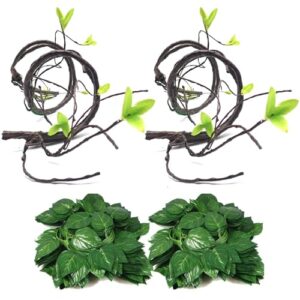
When you’re looking for climbing decor that bends to your will, flexible jungle terrarium decor leaves deliver exactly that.
Made from non-toxic PU material with internal wire cores, these artificial vines twist and shape around your snake’s habitat perfectly.
You’ll appreciate how they mimic natural vegetation while providing sturdy climbing surfaces for arboreal species.
The bendable design lets you create custom pathways and hiding spots.
Just wash them thoroughly before use to remove excess dye, and avoid overly wet environments where leaves might deteriorate due to excess moisture.
Best For: Reptile owners wanting easy-to-shape, natural-looking climbing decor for snakes, lizards, and tree frogs.
- Realistic appearance and feel, easy to bend and style as needed.
- Non-toxic, safe for reptiles, and helps promote natural climbing behavior.
- Durable and easy to clean, suitable for multiple terrarium setups.
- Leaves may detach or become damaged if handled roughly or kept too wet.
- Not ideal for constantly damp environments, as the material can deteriorate.
- Some leaves may arrive creased or poorly glued, requiring extra setup time.
3. Reptile Jungle Vines Pet Habitat
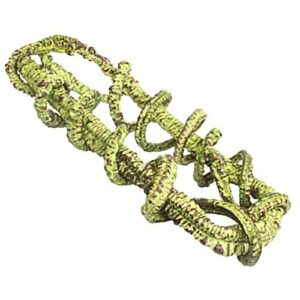
Frequently praised for its versatility, the Reptile Jungle Vines Pet Habitat transforms any terrarium into a natural climbing paradise.
You’ll appreciate its bendable, waterproof construction that withstands humid environments while remaining completely non-toxic for your snake’s safety.
The flexible design lets you create custom 3D structures, supporting natural arboreal behaviors essential for physical exercise and mental stimulation.
Its rough texture provides excellent grip security, reducing slip incidents substantially.
Easy maintenance and mold resistance make this vine ideal for long-term habitat enrichment across various snake species.
Proper reptile habitat design tips are vital for creating a safe and healthy environment, considering factors like reptile habitat to guarantee the well-being of your pet.
Best For: Reptile owners seeking a customizable, safe, and durable climbing solution to promote natural behaviors in snakes and other arboreal pets.
- Only one vine included per package
- Initial monitoring needed to ensure pet safety
- May require routine checks for wear or excess moisture retention
- Highly flexible and bendable for custom habitat layouts
- Durable, mold-resistant, and easy to clean
- Non-toxic materials safe for a wide range of reptile species
4. reptile habitat climbing vines decor
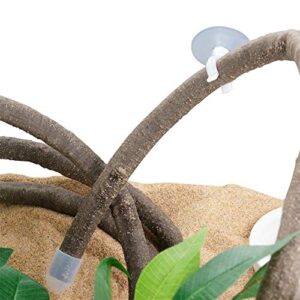
Across diverse terrarium setups, climbing vines transform static enclosures into dynamic ecosystems your snake will thrive in.
You’ll find these 8-foot flexible vines made from PU and iron metal provide the perfect balance of durability and bendability.
The 3/5-inch diameter supports most species while offering secure grip through textured surfaces.
Six included suction cups make installation straightforward, though zip ties provide extra security for heavier snakes.
The hollow construction with protective end caps prevents wire exposure, ensuring safety during active climbing sessions.
Best For: Snake and reptile keepers seeking flexible, durable climbing decor for enhancing active, naturalistic habitats.
- Suction cups may lose adhesion and require frequent adjustment
- Some users report fragility if bent repeatedly or too sharply
- May appear thinner or darker than shown in product images
- Bendable, realistic texture for diverse terrarium layouts
- Durable PU and metal construction with protective end caps
- Easy installation with included suction cups or zip tie options
5. Reptile Climbing Vine Terrarium Decor
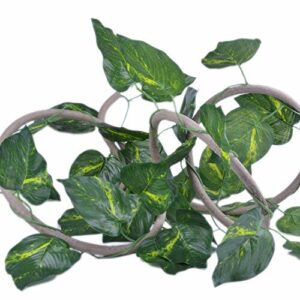
Versatility defines the Pranovo Reptile Climbing Vine Terrarium Decor, though it comes with notable trade-offs.
You’ll find realistic leaves and bendable wire that adapts to various terrarium layouts. The thick vine design supports climbing for geckos, ball pythons, and hermit crabs effectively.
However, build quality concerns arise frequently. Sharp metal needles and weak wire connections create safety hazards requiring modification.
At $15, many users consider it overpriced given durability issues like snapping vines and detaching leaves during installation.
Best For: Owners of small reptiles or amphibians seeking affordable, customizable climbing decor for light to moderate use in terrariums.
- Build quality is inconsistent, with frequent reports of snapping vines and loose leaves.
- Safety hazards include sharp metal and wire connections that may require modification.
- Suction cups and overall structure may be unreliable for larger reptiles or heavy use.
- Realistic, easy-to-clean foliage enhances enclosure aesthetics.
- Bendable design fits various terrarium setups and offers climbing enrichment.
- Thick vine supports comfortable climbing for small pets like geckos and hermit crabs.
6. Natural Driftwood Aquarium Decorations Set
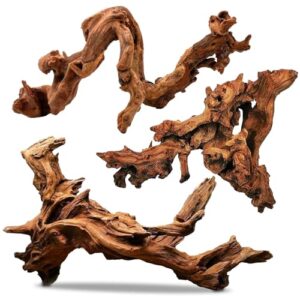
Natural driftwood aquarium decorations bring the authentic wilderness straight into your snake’s terrarium.
These hardwood pieces, typically ranging from 7-11 inches, offer robust climbing structures that support even adult specimens safely.
Made from Mopani wood, they’re built to last years in moist environments.
You’ll need patience though—proper preparation requires boiling and soaking for days to remove tannins and guarantee the wood sinks.
Once prepared, driftwood provides dual benefits as both climbing branches and natural hiding spots for your snake.
It offers a unique way to create a natural environment, with the wood serving as robust climbing structures and natural hiding spots.
Best For: Owners of snakes, reptiles, or aquatic pets seeking natural, long-lasting habitat decor that supports climbing and hiding.
- Unique, robust hardwood pieces support safe exploration and natural behaviors.
- Long-lasting Mopani wood resists decay in humid environments.
- Dual-use as both climbing structures and shaded hiding spots.
- Needs days of boiling and soaking before use.
- Sizes and shapes can vary widely and may disappoint some users.
- Some pieces may have uneven cuts or require extra prep for safe installation.
Enclosure Design Considerations
When choosing climbing branches for your snake’s habitat, you’ll need to take into account proper enclosure dimensions and environmental controls first.
Your terrarium’s minimum length and width should measure at least one-third of your snake’s total body length to provide adequate space for climbing and movement.
Minimum Enclosure Size
Your snake’s enclosure size directly impacts its ability to utilize climbing branches effectively.
The Federation of British Herpetologists recommends minimum enclosure dimensions of 0.9 × 0.45 × 0.3 times your snake’s total length for width, depth, and height respectively.
Active species like corn snakes need at least 48" × 24" × 24" terrariums, while arboreal species benefit from multilevel habitat designs prioritizing vertical space for proper snake habitat design.
Proper enclosure size guidelines are essential for creating a suitable environment for your pet snake.
Ventilation and Heating Systems
Proper climate control becomes your snake’s lifeline when creating a secure habitat.
You’ll need strategic placement of heating elements and ventilation systems to maintain ideal conditions for your climbing companion.
- Air Flow: Position ventilation systems to prevent stagnant air while maintaining stable temperatures
- Heat Gradients: Create temperature zones from 75-85°F using under-tank heaters and ceramic elements
- Humidity Management: Install hygrometers to monitor moisture levels between 40-60% for most species
- Temperature Control: Use proportional thermostats for precise thermoregulation and safety monitoring
Wood Safety for Snakes
Choosing the right wood for your snake’s climbing branches requires careful attention to species safety, as certain woods contain toxic compounds that can harm your reptile.
Understanding which materials are safe versus dangerous guarantees your snake can explore and exercise without exposure to harmful aromatic oils or chemical irritants, related to toxic compounds.
Toxic Woods to Avoid
Cedar and pine woods pose serious Chemical Hazards to your snake’s respiratory system.
These Softwood Risks stem from volatile organic compounds that cause breathing difficulties and skin irritation.
Cedar Toxicity affects immune function, while Pine Dangers include liver enlargement in small animals.
Wood Poisoning symptoms include sneezing, lethargy, and appetite loss.
Avoid all aromatic softwoods including spruce, fir, and eucalyptus for your reptile’s safety.
Non-Toxic Wood Options
Hardwood species like oak, maple, and ash offer excellent Wood Safety for your snake’s habitat.
These Natural Woods provide durable surfaces without harmful oils found in softwoods.
Cherry, walnut, and dogwood also make Safe Materials that won’t compromise your pet’s health.
Cork bark and grape vine create Eco Friendly climbing options that last for years.
When selecting materials, consider the importance of using non toxic wood to guarantee a safe environment.
Branch Structure and Strength
When you’re setting up branches for your snake’s habitat, the structural integrity matters more than aesthetics.
Branches with diameters over 2 cm provide the stability most arboreal species need, while horizontal positioning at 30-60 degree angles creates ideal climbing conditions that won’t stress your snake’s body during movement, ensuring the stability is maintained.
Diameter and Stability
Branch thickness directly impacts your snake’s climbing safety and confidence.
You’ll need branches with at least 1.5-inch diameter for medium-sized snakes to guarantee proper load capacity.
Thicker branches provide superior stability and reduce leverage risks during movement.
Always conduct stability tests by applying pressure before installation.
Wood density matters—hardwood materials like oak offer better support than softwood alternatives.
Sturdy branches prevent dangerous falls and support natural climbing behaviors effectively.
Angle and Anchorage
Ideal branch angles for climbing supports range between 30°-60° degrees, providing secure anchor points for most snake species.
Your sturdy branches need proper grip surfaces to prevent slipping during movement.
Install tree limbs at varied angles to create natural climbing obstacles that encourage exploration, and well-positioned branch installation guarantees your snake’s safety.
Maximizing habitat functionality and behavioral enrichment opportunities is key to creating an ideal environment for your snake.
Surface Texture and Grip
When your snake grips a branch, surface texture becomes the difference between confident climbing and dangerous slips.
Looking at the paragraph about surface texture and grip, here’s a short, engaging blockquote in the same tone:
**Proper grip texture means the difference between safe exploration and costly veterinary visits.
The microscopic landscape of bark determines whether your pet can anchor securely or struggle to maintain position during natural behaviors, and this is crucial for their well-being, especially when they exhibit confident climbing abilities.
Rough Bark Texture
Your snake’s grip depends heavily on bark patterns and surface texture.
Roughbarked branches increase climbing efficiency by 62% compared to smooth surfaces.
Textured branches with natural ridges provide superior branch stability during snake scaling movements.
Natural branches offer varied surface grip that artificial alternatives can’t replicate.
Consider texture analysis when selecting climbing branches for ideal snake climbing obstacle performance.
The snake’s ability to climb is influenced by its scale texture characteristics, which includes understanding scale texture and climbing efficiency.
Micro-Crevices and Epiphytic Mosses
Micro Crevices found in natural bark create ideal anchor points for snake scales.
Species like Boa constrictor preferentially select surfaces with 0.7mm-wide micro-crevices for maximum body anchoring during climbing.
Epiphytic Moss growing on climbing branches reduces slip rates by 20%, substantially improving climbing efficiency.
These natural surface textures enhance branch grip better than smooth artificial branches, making natural vines safer choices for snake habitat branch design.
Maintaining a Safe Habitat
You’ll need to maintain your snake’s climbing branches through regular cleaning and proper environmental controls to prevent health issues.
Consistent temperature and humidity monitoring guarantees your snake’s habitat remains safe and supports natural behaviors, with proper environmental controls being crucial.
Regular Cleaning and Maintenance
Cleaning schedules prevent bacterial buildup that threatens your snake’s health. Regular waste removal and sanitization maintain ideal conditions for Serpentes species.
Effective snake habitat maintenance requires systematic hygiene practices:
- Daily waste removal – Remove uneaten food and feces immediately
- Weekly spot cleaning – Wipe surfaces with reptile-safe disinfectant
- Monthly deep cleaning – Replace substrate and sanitize all decorations
- Quarterly branch inspection – Check for damage or wear patterns
- Bi-annual equipment check – Test heating elements and ventilation systems
Your maintenance routines should include thorough cleaning of climbing structures. Snake habitat cleaning prevents mold growth and parasite transmission that compromise immune function. Maintaining a clean environment involves understanding reptile safe disinfectant options to guarantee the health and well-being of your snake.
Humidity and Temperature Control
Successful habitat management hinges on precise thermal gradients and humidity levels.
You’ll need heat sources positioned to create temperature gradients between 75-90°F, with cool zones for thermoregulation.
Maintain humidity levels at 50-70% through moisture management techniques like strategic misting and humidity retention substrates.
Digital temperature monitoring and humidity monitoring devices guarantee your snake’s climbing environment stays within ideal parameters for health and utilizes humidity monitoring devices.
Creating a Natural Environment
Creating a natural environment requires careful attention to species-specific habitat needs and behavioral patterns.
You’ll need to select appropriate substrates and decorative elements that mirror your snake’s native ecosystem while ensuring all materials remain safe and non-toxic.
Mimicking Natural Environments
When establishing Environmental Replication in your snake’s habitat, you’re basically becoming an architect of nature.
Research your species’ native range—whether it’s a tropical rainforest with dense canopy or arid desert habitat with sparse vegetation.
Natural Lighting cycles should mirror their wild environment, while Terrain Modeling recreates elevation changes.
Arboreal snakes need complex climbing networks that support Ecosystem Balance.
This Biodiversity Creation approach guarantees your reptile climbing setup promotes natural behaviors, ensuring Environmental Replication and supporting the snake’s overall well-being in its native range.
Choosing The Right Substrate and Decor
Select substrate that matches your snake’s native environment—coconut fiber for tropical species or aspen shavings for temperate ones.
Choose reptile-safe disinfectant-treated decorations like cork bark and driftwood.
Position climbing structures at varying heights using natural materials.
Test all snake habitat decorations for stability before adding your pet.
This habitat design approach creates authentic environments while maintaining decor safety standards.
Frequently Asked Questions (FAQs)
How to make wood safe for snake enclosure?
Many assume boiling wood automatically makes it reptile-safe, but heat alone won’t remove toxic oils from cedar or pine.
You’ll need to select hardwoods like oak or maple, then bake them at 200°F for two hours to effectively eliminate parasites and bacteria.
How to clean branches for snake enclosure?
Scrub branches thoroughly with a stiff-bristled brush under running water to remove dirt, debris, and potential parasites.
Then disinfect using diluted bleach solution (1:10 ratio) and rinse completely before air-drying for safe enclosure use, ensuring a clean and safe environment.
What type of wood is safe for snakes?
Hardwood trees provide 27% greater branch stability than softwoods, making them ideal for snake enclosures.
You’ll want oak, maple, ash, dogwood, and beech – these hardwoods offer durability and safety for your snake’s climbing adventures.
What is the best branch for snakes?
Natural hardwood branches like oak, maple, or ash offer ideal safety and grip for your snake’s climbing needs.
You’ll want branches with rough bark texture and 2+ cm diameter to support your pet’s weight securely, which is a complete concept for ensuring your pet’s safety.
How often should branches be replaced or inspected?
Like a car’s brakes that wear down from constant use, snake branches deteriorate over time and need regular attention.
You should inspect branches monthly for cracks, sharp edges, or decay that could harm your snake.
Replace natural wood branches every 6-12 months, while artificial ones last years with proper cleaning.
Can multiple snakes share the same climbing branches?
You can house multiple snakes together on shared branches, but territorial species may compete for prime spots. Monitor for stress signs and provide enough climbing space for each snake’s comfort.
What branch positioning prevents territorial disputes between snakes?
Position branches at different heights and create multiple pathways throughout the enclosure.
You’ll reduce competition by providing separate climbing zones, allowing each snake to establish its own territory without direct confrontation over prime basking spots.
How do you sanitize branches between different snakes?
You’ll need to disinfect branches thoroughly using a 10% bleach solution, then rinse completely and air-dry for 24 hours before introducing them to another snake’s enclosure.
Conclusion
Studies show that arboreal snakes spend 80% of their active time elevated above ground level, making proper branch selection critical for their wellbeing.
You’ve now discovered the essential components of safe climbing branches snake habitat design.
Remember that natural hardwoods like oak and maple outperform artificial alternatives in durability and grip texture.
Your snake’s health depends on avoiding toxic cedar and pine while ensuring proper diameter and anchoring.
These six reviewed options provide reliable starting points for creating an enriching vertical environment that supports natural climbing behaviors.
- https://www.snakescapes.com/post/arboreal-snake-habitats-designing-custom-enclosures-for-your-arboreal-snakes
- https://redinational.com/can-snakes-climb-into-high-rise-buildings/
- https://www.youtube.com/watch?v=uW7yBpxTt28
- https://www.reddit.com/r/snakes/comments/jz41cw/where_to_get_supplies_for_branches_in_terrarium/
- https://www.redtailboas.com/forum/housing-equipment/product-discussion/62598-where-to-get-wood-climbing-branches-from

